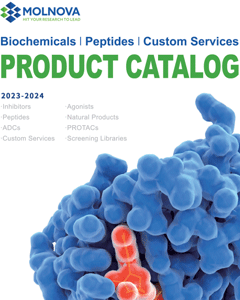
2-MNG
CAS No. 2101538-28-5
2-MNG( —— )
Catalog No. M37607 CAS No. 2101538-28-5
2-MNG (2-Mercaptonicotinoyl glycine) acts as an inhibitor of melanin production, displaying an average IC50 of 49.5μM in normal human melanocytes.
Purity : >98% (HPLC)
 COA
COA
 Datasheet
Datasheet
 HNMR
HNMR
 HPLC
HPLC
 MSDS
MSDS
 Handing Instructions
Handing Instructions
| Size | Price / USD | Stock | Quantity |
| 500MG | Get Quote | Get Quote |


|
| 1G | Get Quote | Get Quote |


|
Biological Information
-
Product Name2-MNG
-
NoteResearch use only, not for human use.
-
Brief Description2-MNG (2-Mercaptonicotinoyl glycine) acts as an inhibitor of melanin production, displaying an average IC50 of 49.5μM in normal human melanocytes.
-
Description2-MNG (2-Mercaptonicotinoyl glycine) acts as an inhibitor of melanin production, displaying an average IC50 of 49.5μM in normal human melanocytes. It binds to melanin precursors, preventing their incorporation into growing melanin which results in the inhibition of eumelanin and pheomelanin synthesis. Additionally, 2-MNG can be used in studies related to skin pigmentation disorders.
-
In Vitro——
-
In Vivo——
-
Synonyms——
-
PathwayOthers
-
TargetOther Targets
-
RecptorOthers
-
Research Area——
-
Indication——
Chemical Information
-
CAS Number2101538-28-5
-
Formula Weight212.23
-
Molecular FormulaC8H8N2O3S
-
Purity>98% (HPLC)
-
Solubility——
-
SMILESO=C(O)CNC(=O)C1=CC=CNC1=S
-
Chemical Name——
Shipping & Storage Information
-
Storage(-20℃)
-
ShippingWith Ice Pack
-
Stability≥ 2 years
Reference
molnova catalog



related products
-
Tafamidis
Tafamidis is a kinetic stabilizer of transthyretin (TTR) that prevents amyloidogenesis by wild-type and mutant TTRs.
-
Sibiricaxanthone?A
Sibiricaxanthone?A is a natural product from Polygala tenuifolia.
-
Interleukin-1β Conve...
Interleukin-1β Convertase Substrate



 Cart
Cart
 sales@molnova.com
sales@molnova.com


